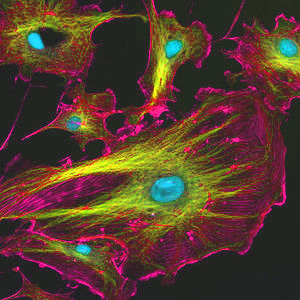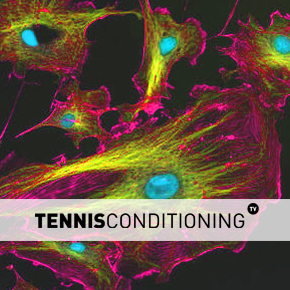
Conceptually, a cell can be thought of as a factory that can produce (synthesize) various compounds to ensure that the body operates properly. A single cell can be divided into three parts:
- cell (or plasma) membrane
- nucleus
- cytoplasm
Cell Membrane:
The cell membrane is semipermeable, which means that certain substances can enter the cell but others cannot. Its main responsibility is to:
- safe-guard the inner components of the cell
- control the movement of substances that can enter and leave the cell
- provide receptors for specific molecules arriving from outside the cell.
There are 3 mechanisms by which substances can pass through the cell membrane:
- Diffusion: small, lipophilic (fat-soluble) molecules (e.g. oxygen) freely pass through the membrane like a VIP at a concert (e.g.water/small fats)
- Facilitated Diffusion (specific transport mechanisms): hydrophilic (water-soluble substances) and/or small charged molecules (glucose, amino acids, ions) cannot simply pass through the membrane into the cell by diffusion; they have to wait for the transport mechanisms to carry them over or to open channels for them to pass through
- Active Transport (Vesicular (Bulk) Transporter): they move large macromolecules (e.g. glucose) via two processes, called endocytosis (into the cell) and exocytosis (out of the cell). There are three ways for a large molecules to enter the cell (endocytosis):
- Phagocytosis: “cell eating”; bacteria and/or waste are engulfed by phagosomes and then fuse with lysosomes, which carry enzymes that destroy the content of the phagosomes.
- Pinocytosis: small vesicles carry fluids inside the cell; means “cell drinking” and is being used by most cells to sample the surrounding extracellular fluid.
- Receptor-Mediated Endocytosis: is a key-and-lock mechanism, where a substance (e.g. hormones, low-density lipoproteins carrying cholesterol) binds to a specific receptor on the membrane and is shipped into the cell by vesicles; you can think if these as a guest-list-only event at a club: the bouncers at a club who only allow people come in that are on the list, everyone else has to wait outside. Lysosomes bind to the vesicle inside the cell and release its content into the cytoplasm.
The cell membrane (plasmalemma; sarcolemma in muscle tissue; “lemma” means sheath) is double-layered; it is made of (phospho) lipids & protein.
Nucleus:
The nucleus is located in the center of the cell and it contains the genetic code (genes) – DNA (deoxyribonucleic acids). Genes regulate protein synthesis (determines cell composition) and cellular activity.
Cytoplasm:
Cytoplasm (= sarcoplasm in muscle cells; means “cell-forming material”) is the cell fluid, which consists of (1) organelles (“little organs”) and (2) enzymes. Most of the cellular activity occurs in the cytoplasm. The cytoplasm holds 8 important organelles:
Organelle |
Function |
| Mitochondria |
|
| Ribosomes |
|
| Lysosomes |
|
| Peroxisomes |
|
| Rough Endoplasmic Reticulum (ER) |
|
| Smooth Endoplasmic Reticulum (ER) |
|
| Golgi Apparatus |
|
| Cytoskeleton |
|
The Roles of Enzymes in Chemical Reactions
Enzymes have two functions, (1) they control the speed of cellular chemical reactions and (2) they control the metabolic pathways in cells. Enzymes do not cause a reaction but they control/regulate the speed at which the reactions occur.
Enzymes (which are proteins) regulate the speed of a chemical reaction by lowering the energy of activation, which is the initial energy required so that a reaction can actually occur; by lowering the initial energy of activation enzymes increase the rate of product formation. When enzymes increase the speed of a chemical reaction in cells, then they are called catalysts. For an enzyme to work as a catalyst, the enzyme molecule must first bind to a reactant molecule, called substrate. The enzyme (catalyst) molecule acts on the reactant molecule (substrate) to generate a product molecule, which is subsequently being released. Theoretically, one enzyme molecule could generate multiple product molecules. In reality, enzymes act on two or more different substrates and generate more than one product. Only if a substrate molecule closely fits and binds to a particular site on the enzyme molecule, called the active site, can the enzyme act on the substrate and catalyze (accelerate) the reaction (Lock-and-Key model).
Although enzymes are proteins, many enzymes possess other non-protein components called cofactors, which are necessary for the enzymes to function properly. Other enzymes contain vitamins and this vitamin-derived cofactors function as coenzymes, which act as transport molecules to carry chemical components from one reaction to another so that enzymes can fulfill their functions.
There are three coenzymes that are important in energy metabolism:
- Flavin Adenine Dinucleotide (FAD)
- Nicotinamide Adenine Dinucleotide (NAD)
- Coenzyme A (CoA)
FAD and NAD participate as hydrogen (electron) carriers in certain oxidation-reduction reactions and they transport electrons from one place to another inside cells. FAD acquires electrons by picking up pairs of hydrogen atoms (have 1 electron each), which then are brought and released to electron acceptors. NAD picks up one electron in a hydrogen atom and the other electron comes as a free electron, which is “stolen” from another hydrogen atom. Only the free electron of a hydrogen atom is “stolen” and the rest remains as is (leaving a hydrogen ion solution). Coenzyme A picks up chemical groups, called acetyl groups, in certain metabolic reactions and brings them to another reaction.
Factors Altering Enzyme Activity
Factors that alter enzyme activity are equivalent with the rate by which the enzymes’ substrate is converted into products. There are two factors that influence enzyme activity:
- the temperature of the enzyme solution (products)
- pH (acidity level) level of the enzyme solution
Enzyme activity is best at body temperature (37˚C) or slightly above it. ATP production then increases during exercise because the speed at which reactions occur also increases due to enhanced enzyme activity.
Each enzyme has its own optimal pH level at which enzyme activity is most efficient. During heavy exercise, skeletal muscles produce large quantities of lactic acid. Lactic acid is a strong acid which leads to a decrease in body pH levels (increase in acidity). This decrease in body pH levels ultimately leads to a strong decrease in ATP production, which results in the cessation of work.
Picture Credit
© by AJC1 @ Flickr


